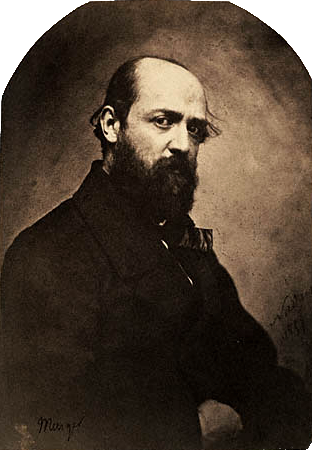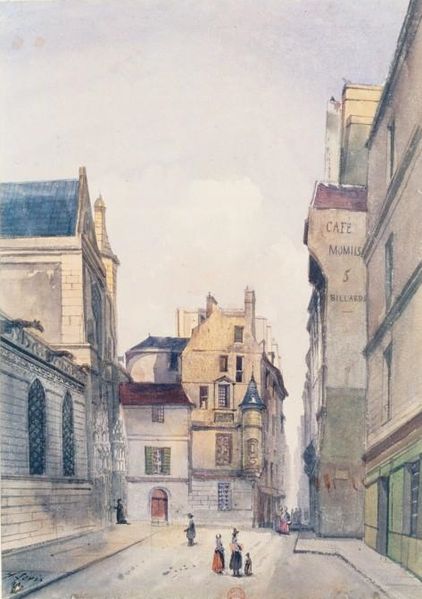The Bohemian Life According to Henri Murger (1822-1861)
![]() By Dyana Neal
By Dyana Neal
It’s probably safe to say that Henri Murger’s novel Scènes de la vie de Bohème (or, as some English translations are titled, Latin Quarter) isn’t widely read today. Most of us know Murger’s book, and the Bohemian characters it depicts, only through Puccini’s opera La Bohème. Puccini’s opera is much beloved, and deservedly so, but it does show the characters and their lifestyle in a rather rosy light. Murger’s novel, by contrast, is an affectionate yet not overly romantic portrait of young Parisians in the early 1840’s. Murger knew the world he wrote of very well – born in Paris, he was the son of a landlord whose tenants included numerous artistic types. As a young man, Murger was briefly employed by a law firm, but lost his position due to the number of working hours he spent socializing at Latin Quarter cafes (including the Café Momus!) There, he became friends with all manner of artists, philosophers, composers, and writers – the real-life models for the characters in his Scènes. Murger and his friends called themselves “The Water Drinkers” as they were often too broke to afford any other beverage. The character of Rodolphe (Rodolfo in La Bohème) is based on Murger himself, while Mimi represents Lucile Louvet, a florist who was the author’s mistress.

Henri Murger
Scènes de la vie de Bohème didn’t begin life as a novel. As was common in the 19th century, the stories were first serialized, these in 1845 in a rather obscure magazine called Le Corsaire, where they met with only modest success. Everything changed when an aspiring dramatist, Theodore Barriere, suggested to Murger that the Scenes might lend themselves well to a theatrical adaptation. The resulting play, La vie de Bohème, was a huge hit, garnering its two authors a great deal of attention. (Puccini and his two librettists, Illica & Giocosa, based La Bohème on the stage version, not the book, but had to insist otherwise due to copyright issues.) When they were approached by publisher Michel Levy about turning the play into a novel, Barriere and Murger immediately accepted. The novel sold very well, and ironically, Murger used his share of the proceeds to move out of the Latin Quarter and into a respectable, alas, bourgeois neighborhood. He never wrote another memorable work.
Yes, the world’s most famous Bohemian abandoned his unheated garret, and had probably been aspiring to do so for years. Murger didn’t invent the term “Bohemia” to describe the starving artist’s world, but he certainly increased its fame. For Murger and his contemporaries, Bohemia was merely a stop on the journey to a financially lucrative career, perhaps in the arts, perhaps not. Bohemia was more a state of mind than a place – one who wished to be called Bohemian should be devoted to arts and letters, disdainful of “bourgeois” conventions, poor, and young. The typical male inhabitant of Bohemia was well-educated and came from a middle- or upper-class family, so while the denizens of the Latin Quarter inhabited chilly rooms and did not always have enough to eat, most were never really too far away from a warm bed and a good meal, or at least a bit of financial help. In Murger’s novel, Rodolphe makes a few sous writing advertising copy for his uncle, a manufacturer of stoves. The women of Bohemia tended to come from poorer backgrounds and had to earn their living as seamstresses, flower-sellers, or artists’ models (the latter being considered synonymous with prostitution.) In fact, these women often had to resort to selling their bodies, or at least to being “kept”, to avoid starvation.
Murger’s Bohemians are charming and witty, but a bit more decadent than their counterparts in Puccini’s opera. They drink a great deal, make off with milk delivered to others’ doorsteps, have countless insolent excuses for not paying the rent on time, and order immense feasts they are unable to pay for. Some art does get created in Bohemia, but Rodolphe and his friends spend more time pursuing fine food, wine, and sex than calling upon the Muses. Where romantic entanglements are concerned, the Bohemians are a lusty lot – they have passionate love affairs, write volumes of embittered poetry when their lovers leave, and, despite their supposedly broken hearts, are quick to find new amours. In fact, there is so much “hooking up” going on in Scènes that one wonders how 19th-century parents reacted if they discovered their children (especially their daughters!) reading the book. Most modern readers, however, are likely to find the Bohemians’ rather patronizing attitude toward women more troubling than their sexual behavior. They themselves cannot possibly go into society without the requisite black suit, yet they disdain their mistresses’ desire for fashionable clothes as evidence of inferior morals. Scenes is definitely written from a male point of view – Murger’s female characters aren’t nearly as well-drawn as his men, and his sympathies seem to have been more with Musette than Mimi, which is a bit odd given that the latter was his real-life partner. The lovers of the Latin Quarter do seem to have genuine feelings for each other, but once the men leave Bohemia, they are no doubt destined to marry respectable young ladies of their own class, whose virtue and modesty have been properly preserved.Most had to consider their benefactors’ bank accounts (rather than their looks, age, or personality) but one young Bohemienne of Murger’s acquaintance, Marie-Christine Roux, would have only young, handsome lovers. Her standard of living thus fluctuated wildly – silk gown one day, plain cotton frock the next. Mlle. Roux served as the model for Murger’s Musette – a beautiful, semi-educated country girl whose high spirits help her to deal with her ever-changing fortunes. The scene in which Musette, just evicted from yet another lover-financed flat, arranges her furniture in the courtyard to greet her guests is one of the highlights of Murger’s novel.

Café Momus to the right of the picture, in front of the rectory of the church of Saint-Germain l’Auxerrois . Watercolor by Henry Lévis (1849).
Scènes de la vie de Bohème is a product of its time, yet very accessible to the 21st-century reader. Reading it takes one back to college or graduate school days. The characters and events of Murger’s Bohemia aren’t all that different from those found on a modern university campus or among young creative types trying to establish themselves in the big city. Tuberculosis probably hasn’t carried any of our friends off, but AIDS or substance abuse may well have. The term “Bohemian” is still used to describe a certain type of artist or lifestyle, and many of us are a little nostalgic for our younger days, when we weren’t bothered with mortgage payments, car loans, and the like and were content to sit up all night in our tiny apartments, drinking cheap wine and having passionate discussions. Some live the carefree, financially precarious Bohemian life well into middle age, but most of us, like Murger, reach a point where poverty no longer seems quite so romantic. In a well-heated living room, the modern lapsed Bohemian can read Scènes de la vie de Bohème while curled up on a plush couch, sipping a fine Shiraz. Henri Murger wouldn’t have had it any other way.
A version of this article first appeared in WBJC’s Program Guide in 2006.
The Modell Performing Arts Center at the Lyric is presenting Puccini’s La Bohème on Friday, November 2nd and Sunday, November 4th, 2012.
Related reading:
Trilby (George du Maurier)
The First Bohemian: The Life of Henri Murger (Robert Baldick)
The Legend of the Latin Quarter: Henri Murger and the Birth of Bohemia (Arthur Moss)






